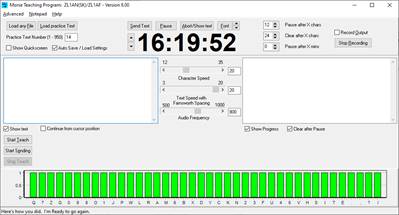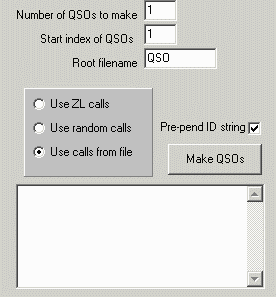Morse Code Learning Tools
Teach Morse
 TeachMorse is a Windows application that works on Windows XP through to Windows 10 and provides a way to play practice text at different speeds. It uses the Howard Cunningham teaching character string which is similar to the ‘Koch’ method.
TeachMorse is a Windows application that works on Windows XP through to Windows 10 and provides a way to play practice text at different speeds. It uses the Howard Cunningham teaching character string which is similar to the ‘Koch’ method.
This software was originally written by Gary Bold ZL1AN (now Silent Key) who was a long time contributor to NZART’s official Journal, Break-In and was known as ‘The Morseman’ by many in the Amateur Community. The software now maintained and enhanced by Andrew Mitchell ZL1AF.
You can download the .exe file for TeachMorse v8 here: TeachMorseV8.02
QSO Make
 QSLmake Version 3: If you learned to read Morse using plain language texts, hearing the format, conventions and abbreviations of a “real” QSO can be a perplexing experience. This program generates any number of sample QSOs as text files, which can be converted to audio Morse using a number of free programs. Typical signal reports, QTHs, Q codes and comments are selected randomly from text files, which can be edited by the user to reflect preference and local conditions.
QSLmake Version 3: If you learned to read Morse using plain language texts, hearing the format, conventions and abbreviations of a “real” QSO can be a perplexing experience. This program generates any number of sample QSOs as text files, which can be converted to audio Morse using a number of free programs. Typical signal reports, QTHs, Q codes and comments are selected randomly from text files, which can be edited by the user to reflect preference and local conditions.
A single file, containing all QSOs concatenated, is also generated, suitable for recording on tape, MP3 etc.
You can download the .exe file for QSOMake-v3 here: QSOMake
Save the .exe file to its own folder and run the file to install.
lcwo.net
Learn CW Online is a website that provides an online set of tools for learning Morse Code using the Koch method.
Feedback: (dated – 20 November 2021):
I’m just reaching out to let everyone at NZART HQ know your collection of Morse Code/CW Learning Tools were a big help to my daughter Corrine and a ‘Famous Inventors and Inventions’ project she’s working on for her technology class. Her teacher thought it would be fun for the class to learn about a new invention or technology each week that changed history. The students are then required write a short paper about what they learned, and how it impacted society. It’s been fun for both of us! Right now we’re learning about the telegraph and Morse Code! Your page led us to some great websites to check out, so Corrine and I wanted to make sure we thanked you!! I was also hoping you could add a contribution from Corrine to your page? She found this timeline of the telegraph that I loved. It was neat to see how Morse Code and continuous wave changed the history of communication. This is it….https://www.emissary.ai/telegraph-morse-code-text/ Can you add it on here? I’d love to show Corrine and her teacher! It’s always nice getting some recognition for a job well done, and perhaps Corrine will even get some extra credit? Brownie points would be nice with the next round of report cards coming out soon! The project is due tomorrow, if you get a chance to include it by then! I know the holiday season can be hectic, so if not, whenever you can add it is great! I really appreciate it! 73 (I just learned this!) Mrs. Sarah Jackson
